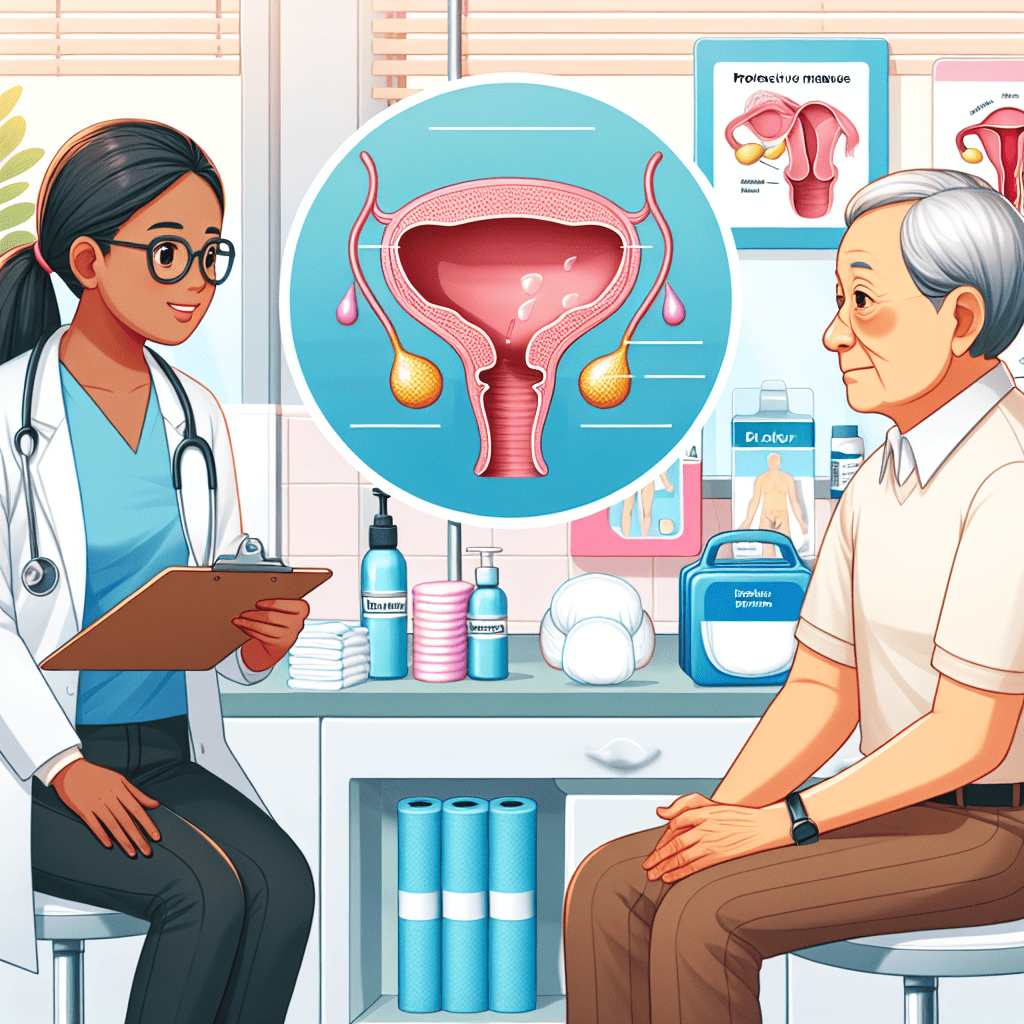Introduction: Urinary incontinence can be a challenging condition that impacts daily life. Recognizing the symptoms and implementing management techniques are crucial steps towards regaining control and improving your quality of life. This article delves into the symptoms of urinary incontinence and provides effective techniques for better management.
Table of Contents
Symptoms of Urinary Incontinence
Identifying the symptoms of urinary incontinence is essential for seeking appropriate management and treatment. Here are some common signs to watch out for:
- Urinary Leakage During Activities:
Urinary incontinence is a condition that can manifest in different ways, including stress incontinence, which causes leakage during activities that put pressure on the bladder. These activities can range from high-impact exercises to merely sneezing or laughing. The leakage occurs because the pelvic floor muscles, which support the bladder and urethra, are weakened or damaged, making it challenging to control urination. As a result, individuals may feel embarrassed, anxious, or conscious about potential accidents, leading to a significant impact on their quality of life.
In addition to stress incontinence, there are other types such as urge incontinence, overflow incontinence, and mixed incontinence, each with its own set of triggers and underlying causes. It’s essential to seek medical advice to determine the specific type and cause of urinary incontinence to receive appropriate treatment. Treatment options can include lifestyle modifications, pelvic floor exercises, medications, or in severe cases, surgery. Seeking professional help allows individuals to manage their symptoms effectively and regain control over their bladder function.
Living with urinary incontinence can be challenging, but it’s essential to remember that it’s a common condition that affects people of all ages. Seeking support from healthcare providers, joining support groups, and making necessary changes to your lifestyle can help in coping with the condition. It’s crucial to address any concerns or issues related to urinary incontinence openly and proactively to improve your overall well-being and regain confidence in daily activities. With the right approach and management strategies, individuals can lead fulfilling lives while effectively managing their symptoms.
- Inability to Hold Urine:
Urinary incontinence is a common condition that affects many individuals, particularly as they age. It can manifest in various forms, one of which includes difficulty holding urine after experiencing a sudden urge to urinate. This symptom often leads to accidents, where leakage occurs before reaching the toilet. The feeling of urgency can be overwhelming and uncomfortable, causing distress and inconvenience for the individual. It can impact daily activities and social interactions, leading to embarrassment and a decreased quality of life.
The sudden and intense urge to urinate is a significant characteristic of an overactive bladder, which is a type of urinary incontinence. This condition is marked by the bladder muscles contracting involuntarily, creating a strong urge to urinate even when the bladder may not be full. As a result, individuals may experience leakage or accidents due to the inability to hold urine until reaching a restroom. Overactive bladder can be triggered by various factors, including certain foods or beverages, urinary tract infections, neurological disorders, and hormonal changes. Treatment options for overactive bladder may include lifestyle modifications, pelvic floor exercises, medications, or in severe cases, surgical interventions.
Managing urinary incontinence and the associated symptom of difficulty holding urine after feeling a sudden urge to urinate typically involves a comprehensive approach. Consulting with a healthcare provider is essential to determine the underlying cause of the condition and develop an individualized treatment plan. This plan may include behavioral techniques, such as timed voiding and bladder training, as well as incorporating dietary changes and fluid management strategies. Pelvic floor exercises, also known as Kegel exercises, can help strengthen the muscles that support urinary control. In some cases, medical interventions like medications to relax the bladder or surgical procedures to improve bladder function may be necessary. It is crucial for individuals experiencing urinary incontinence to seek support, as there are effective ways to manage and improve symptoms to enhance their overall well-being.
- Nocturnal Incontinence:
Nighttime urinary incontinence, also known as nocturnal enuresis, is a common condition characterized by the involuntary release of urine during sleep. It can affect both children and adults, though it is more prevalent in children. For children, it is often a normal part of development and may resolve on its own over time. However, in adults, nighttime urinary incontinence can be a sign of an underlying medical issue that requires attention.
There are several potential causes of nighttime urinary incontinence in adults, including urinary tract infections, bladder abnormalities, hormonal imbalances, and neurological disorders. In some cases, certain medications or lifestyle factors such as consuming caffeine or alcohol before bed can also contribute to the problem. Diagnosis typically involves a thorough medical history, physical examination, and possibly additional tests such as urine analysis or imaging studies to identify the root cause of the incontinence.
Managing nighttime urinary incontinence often involves a combination of lifestyle modifications, behavior therapy, and medical interventions. Treatment options may include bladder training exercises, dietary changes, pelvic floor exercises, and medication. In more severe cases or when conservative treatments are ineffective, procedures such as bladder injections or surgery may be considered. It is important for individuals experiencing nighttime urinary incontinence to consult with a healthcare provider to determine the most appropriate course of action tailored to their specific needs and circumstances.
Management Techniques
Taking proactive steps to manage urinary incontinence can improve your confidence and overall well-being. Here are some effective techniques to help you regain control:
- Use Leak Protection Products:
Incontinence pads and leak prevention products are essential tools for individuals experiencing incontinence. They are designed to absorb and contain urine, offering comfort and security during daily activities. By providing a layer of protection between the skin and moisture, these products help prevent skin irritation and discomfort that can result from leaks. Additionally, incontinence pads come in various sizes and absorbency levels to cater to different needs, ensuring that individuals can find the right product that suits their specific requirements.
While incontinence pads and leak prevention products do not treat the underlying causes of incontinence, they play a crucial role in managing the condition effectively. By using these products, individuals can go about their daily routines with greater confidence, knowing that they are protected against leaks and accidents. This sense of security can significantly improve overall well-being and quality of life for people dealing with incontinence. Furthermore, by minimizing the risk of embarrassment and discomfort associated with leaks, these products help individuals maintain their dignity and independence.
In addition to offering physical comfort and security, incontinence pads and leak prevention products can also provide peace of mind to individuals struggling with incontinence. Knowing that they have access to reliable products that can effectively manage their condition allows individuals to focus on other aspects of their lives without constant worry about leaks or accidents. This mental reassurance can lead to reduced stress and anxiety related to incontinence, promoting better emotional well-being. Ultimately, incontinence pads and leak prevention products not only offer practical benefits but also contribute to enhancing the overall quality of life for individuals coping with incontinence.
- Bladder Muscle Training:
Pelvic floor exercises, also known as Kegel exercises, are often recommended by healthcare professionals to address bladder control issues and urinary incontinence. These exercises target the muscles that support the bladder, uterus, and bowels, playing a crucial role in controlling urination. By regularly practicing pelvic floor exercises, individuals can strengthen these muscles, which in turn can improve bladder control and reduce the symptoms of incontinence. The exercises involve contracting and relaxing the muscles of the pelvic floor, much like stopping the flow of urine midstream.
Improving muscle tone and coordination in the pelvic floor muscles can be beneficial for individuals experiencing bladder control problems. Stronger pelvic floor muscles can provide better support for the bladder and surrounding organs, helping to prevent leaks and reduce the frequency of accidents. Additionally, enhancing the coordination of these muscles can lead to better control over urinary function, allowing individuals to better regulate the timing and urge to urinate. With consistent practice and guidance from healthcare professionals, many individuals see significant improvements in their bladder control and reduction in symptoms of incontinence over time.
It is essential to consult with a healthcare provider or a pelvic floor specialist before starting any pelvic floor exercises to ensure they are appropriate for your specific needs. These professionals can provide guidance on the correct techniques for performing the exercises and create a tailored exercise plan based on individual requirements. Along with targeted exercises, lifestyle modifications such as maintaining a healthy weight, managing fluid intake, and avoiding bladder irritants can also contribute to better bladder control. By committing to a comprehensive approach that includes both exercises and lifestyle changes, individuals can effectively strengthen their pelvic floor muscles, improve bladder control, and reduce the impact of urinary incontinence on their daily lives.
- Monitor Liquid Intake:
Maintaining awareness of your fluid intake is crucial for overall health and can positively impact your bladder function. While staying hydrated is essential, being cautious of caffeinated drinks that have diuretic properties can be beneficial. Caffeine, often found in beverages like coffee, tea, and certain sodas, can increase urine production, leading to more frequent trips to the bathroom. By being mindful of your consumption of these beverages, especially in the evening, you can potentially reduce the likelihood of interruptions to your sleep due to trips to the bathroom.
In addition to monitoring your intake of caffeinated beverages, managing your overall water consumption is key to supporting bladder health. Dehydration can irritate the bladder and exacerbate conditions like urinary tract infections or incontinence. By striking a balance between staying adequately hydrated and avoiding excessive fluid intake, you can help regulate your bladder function. It’s important to remember that individual water needs can vary based on factors such as age, activity level, and overall health. Consulting with a healthcare provider can help you determine an optimal fluid intake that suits your specific needs.
Incorporating healthy habits like maintaining a balanced fluid intake and being mindful of caffeine consumption can contribute to better bladder control and overall well-being. Along with these strategies, establishing a regular bathroom routine, practicing pelvic floor exercises, and maintaining a healthy weight can also support bladder health. If frequent urination or other bladder-related issues persist despite these measures, it’s advisable to seek guidance from a healthcare professional to rule out any underlying medical conditions and receive appropriate treatment. By taking a proactive approach to managing your fluid intake and engaging in bladder-friendly practices, you can promote better bladder function and enhance your quality of life.
Conclusion
Urinary incontinence should not restrict your lifestyle. By understanding the symptoms and implementing practical management techniques, you can take control of your condition and enjoy life to the fullest
One important aspect of managing urinary incontinence is the recognition of its signs and symptoms. Common signs include leaking urine during everyday activities such as sneezing, coughing, or exercising, as well as frequent and sudden urges to urinate. By being aware of these indicators, individuals can seek appropriate treatment and implement preventive measures to better manage the condition.
In addition to being proactive in recognizing the signs of urinary incontinence, there are various strategies that can help individuals effectively cope with the condition. Leak protection products, such as pads or disposable underwear, can provide a sense of security and prevent embarrassing situations. Bladder muscle training, also known as pelvic floor exercises, can strengthen the muscles that control urination, improving bladder control over time. Furthermore, monitoring fluid intake, especially avoiding caffeine and alcohol which can irritate the bladder, can help regulate urinary frequency and decrease the likelihood of accidents.
Overall, managing urinary incontinence involves a multi-faceted approach that combines awareness, lifestyle adjustments, and targeted interventions. By taking proactive steps like recognizing symptoms early on, utilizing appropriate products for protection, engaging in muscle training exercises, and making conscious choices about fluid intake, individuals can regain control over their bladder functions and minimize the impact of incontinence on their daily lives. Seeking guidance from healthcare professionals and support groups can also provide valuable resources and support in effectively managing this common condition.
Seeking support from healthcare providers, such as your primary care physician or a urologist, is crucial in effectively managing urinary incontinence. These professionals can help diagnose the underlying causes of the condition and provide personalized treatment options based on your specific needs. Treatment for urinary incontinence may include pelvic floor exercises, bladder training, medications, or in severe cases, surgical interventions. Additionally, your healthcare provider can offer guidance on managing dietary factors, such as caffeine and alcohol consumption, that may exacerbate symptoms. By working closely with your healthcare team, you can develop a comprehensive plan to address urinary incontinence and improve your quality of life.
While living with urinary incontinence can be challenging, it is important to remember that you are not alone. Connecting with support groups or seeking counseling can provide emotional support and valuable tips from others who are managing similar experiences. Sharing your concerns and seeking guidance from peers can help reduce feelings of isolation and boost your confidence in managing urinary incontinence. Remember that with determination, education, and support, you can take control of your condition and lead a fulfilling life. By taking proactive steps to empower yourself with knowledge and seek professional support, you can navigate the challenges of urinary incontinence with resilience and confidence.




